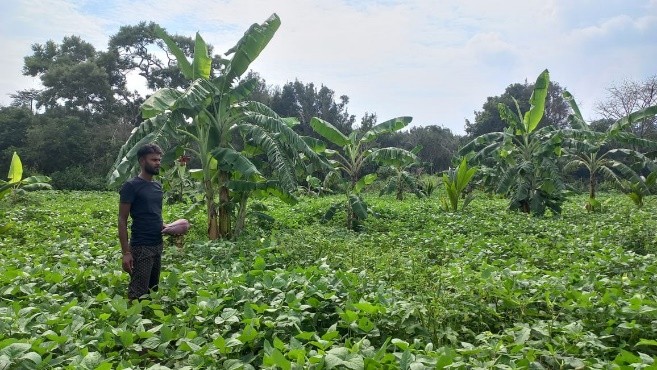Evidence Based Advocacy on Agroecology
Critics of agroecology often focus on economic challenges, arguing that Agroecology cannot match the efficiency and productivity of conventional agriculture. They point to concerns about lower yields per hectare, particularly during the transition period from conventional to agroecological practices, which can take 3-5 years for soil regeneration. They emphasize the higher labor costs associated with manual weed control, natural pest management, and diverse crop maintenance, suggesting these factors make Agroecology economically unviable for farmers who need immediate returns. They also question the scalability of Agroecological practices, arguing that without chemical inputs and mechanization, it cannot meet growing food demand or compete in global markets.
When considering the technical perspective of Agroecology, during the synthetic fertilizer ban and organic agriculture promotion period in Sri Lanka, critics highlighted the perceived limitations in pest and disease management without synthetic pesticides, especially during severe infestations or unusual weather patterns. They argue that Agroecological practices lack the precision and reliability of conventional farming methods, making crop protection more challenging and unpredictable. Some questioned the scientific basis of companion planting and natural pest control, suggesting these methods are not sufficiently validated by research. Technical criticisms also extend to concerns about quality control, standardization of practices, and the complexity of managing multiple crops and ecological interactions simultaneously.
For MONLAR, responding to these criticisms with evidence-based advocacy is crucial. It will help us in advancing Agroecology’s Adoption and Policy Support. With the support of We Effect, two and half years ago we have started creating strong evidence-based responses, that can demonstrate how agroecological systems reduce input costs, improve long-term soil fertility, and build climate resilience while maintaining competitive yields. We started documentation of successful cases, scientific studies showing biodiversity benefits (with other projects), and economic analyses of reduced external input dependency can effectively counter the skepticism. Through this approach, we will start lobbying to policymakers and agricultural institutions. Also providing farmers with concrete evidence to support their transition to agroecological practices, will prove evidence-based advocacy is particularly powerful when it combines scientific data with farmer experiences, showing both the theoretical framework and practical success of agroecological methods.
Poosarikulam: Profile
The people of Poosarikulam earn their living mainly as agricultural laborers, a reality that is a key factor in the poverty that prevails in the village. Dependence on agricultural labor as the main source of income has led to economic limitations and hardship within the community. Some of them work as Agri-laborers and locate, remove, and dispose of landmines in nearby locations. Despite their diligent efforts to cultivate the land, the income generated by farming activities is often insufficient to meet basic needs and aspirations. This heavy reliance on a single form of employment has contributed to a cycle of poverty, preventing villagers from accessing a better standard of living and a more diverse range of economic opportunities. As the community strives to break out of this cycle, interventions to diversify income sources and improve education and skills development prospects are essential to improving the living conditions and economic resilience of the people of Poosarikulam.
The village has around 60 families, with the aim of diversifying the livelihoods and income of farmers we have started 21 demonstration farms based on Agroecology. The community has given continuous training on Agroecology practices and guidance on the transition by MONLAR.
The community has very small land holdings such as homesteads and chena lands of ½ – 2 acres. They maintain their main source of income from daily labor wages due to the vulnerability of the farming practices with the number of issues they face in their farming systems. Key issues are access to water, agriculture inputs, and markets, and elephant attacks are the main bottlenecks they face on a continuous basis. During the last two years, the community continuously suffers from loss of daily wages, food insecurity, access to agriculture inputs, access to markets, etc.




Agroecology Transition
According to Ranjith Kumar (31) The transition to agroecology begins with Education and Capacity Building, he not only practices Agroecology, he also trains other farmers on Agroecology. He is one of the 40 farmers in MONLAR Pilot Farmer Program. “For me, It was not an easy decision to transition into Agroecology, I was worried about the yield and the pest problems where I heard that the organic way of farming doesn’t have good solutions” Ranjith Kumar remembers. However, through regular training I received made me realize that Agroecology is not just organic farming. It is about maintaining an ecological ecosystem and much more” he states. “As farmers, we need to understand and adopt practices that align with ecological principles. Our key training programs focused on agroecological inputs such as Jeewa Mrutham (a microbial-rich organic fertilizer), vermicompost, compost, and Agni Astra (a natural pest repellent made from cow urine, neem, and other botanicals). These inputs restore soil health, enhance microbial activity, and reduce reliance on synthetic chemicals, creating a sustainable farming ecosystem” he mentions in his training.

Ajanthani (29) is the leader of the Community and Secretary of the society. She conducts field visits two times a week to the models and advises the farmers. She also reports back to the MONLAR field Coordinator on developments. “Many of us didn’t believe that we could do home gardening and perennial cropping like this. Most of us do not have access to water. It is very difficult to farm during the dry season. During dry season pest problems increase.” She remembers. Anyhow, we started off very slowly, Ranjith Kumar is one of the first from the teams to start cultivating and everyone saw his progress and it motivated us.” She adds with a bit of enthusiasm. “I don’t have a well, I collect water during the rainy season or I save kitchen wastewater”.

“We learned about different cultivation methods we can practice when doing vegetable gardening” says Shivashalini (22) a young women farmer leader. We used to cultivate a few crops together, but not with a proper crop plan. Now we practice mixed cropping and crop rotation which are central to Agroecology. We didn’t know the science behind mixcropping before but now we do” Mixed cropping involves growing two or more crops simultaneously on the same land, which maximizes resource use, reduces pest outbreaks, and improves soil fertility. For example, integrating legumes like cowpea or green gram with cereals enhances nitrogen fixation, benefiting subsequent crops, which is ideal for Poosarikulam.
Five Layer Method
For Poosarikulam our key Agroecological strategy is the Five-layer system, which mimics natural ecosystems by integrating plants of different heights and root depths. This system includes:
1. Tall trees like coconut or mango for canopy cover.
2. Medium-height trees such as banana or lime for shade and fruit production.
3. Shrubs like pomegranate or guava for intermediate yields.
4. Herbaceous plants such as vegetables or medicinal herbs for ground cover.
5. Root crops like turmeric or ginger for soil aeration and additional income.
This layered approach maximizes land use efficiency, enhances biodiversity, and creates microclimates that support diverse species. Integrating seasonal cash crops like groundnuts, cowpea, green gram and Urud dhal with perennial crops like coconut, lime, banana, and pomegranate ensures year-round productivity and income stability. “This is something that a farmer should invest their time in. It requires much patience since some crops take one or two years to harvest. But the idea is to diversify the model with layers that we will have a harvest year around.” Ranjith Kumar adds. “It is true, Seasonal crops provide short-term returns, and you want to keep cultivating just that. But perennials offer long-term economic and ecological benefits, such as soil conservation and carbon sequestration which my farm now turning into” he adds proudly.


Ranjith Kumar’s Model Farm in 2023 December


Ranjith Kumar’s Model Farm in 2024 December


“For an outsider, this might not look like something such a big deal, says Yogeshwari (46). But for us, this is a big improvement. We were not used to Agroecology before, and we didn’t know why some pests attack intensifies during the season and how to prevent such attacks without using pesticides, and by simply practicing mix cropping or crop rotation”. This is something that we can keep on improving and it will continue to benefit us.” She says hopefully.
Why Agroecology Models?
Demonstration farms and farmer field schools are essential for showcasing these practices. Farmers can observe the benefits of agroecology firsthand, such as improved soil fertility, reduced input costs, and increased resilience to climate shocks. For example, transitioning from chemical-intensive monoculture to mixed cropping with organic inputs can restore degraded soils, enhance water retention, and boost yields over time. By adopting these agroecological practices, farmers can create resilient, productive, and sustainable farming systems. This transition not only improves livelihoods but also contributes to environmental conservation and food security, aligning with the principles of ecological balance and social equity.
ALL CONTACTS
- No. 57, 1st Lane, Meda Welikada Road, Rajagiriya, Sri Lanka.
- +94 112 870 369
- monlar@sltnet.lk
- www.monlar.lk
SUBSCRIBE
Subscribe us to get latest updates of Sri Lankan Peasant movement
Error: Contact form not found.
- Monlar - Copyright 2024
- donations@ong.com
- volunteers@ong.com
- contact@ong.com










Leave a Reply